Yuriko Jackall
This is a case of an alleged artistic crime, the rights and wrongs of which were fought out in the public arena of eighteenth-century Paris as a pitched battle between two painters: the up-and-coming Pierre-Alexandre Wille (1748–1821) and the older, more established Jean-Baptiste Greuze (1725–1805). The latter claimed that the former—his onetime student, no less—had publicly appropriated an idea, an act described as plagiarism in the contemporary press. Subsequently this event has been analyzed in precisely these terms—as an incident of plagiarism—and it is equally in these terms that it has been thought (quite understandably) to have infuriated Greuze, whose behavior consistently demonstrated an obsessive concern with control and authorship.[1] So far, so good. Though if we stop here, it is easy enough to say that the act itself was mitigated by the fact of having occurred in the midst of a century when artistic copying was not just tolerated, but written into the very fiber of academic training.
Yet peeling back the layers suggests motivations, on the one hand, and received wounds, on the other, that elevate what might be taken as an instance of imitation into an attack of Oedipal dimensions upon Greuze’s authorial being. As the former student of a man with a dominant personality, Wille was presumably desperate to step away from his famous teacher’s shadow. As the son of Jean-Georges Wille (1715–1808)—formerly Greuze’s close friend—Wille would have known his old master intimately, on personal terms as well as professional ones. And in the wake of Greuze’s public meltdown at the Salon of 1769, he may have seen the very weakness he needed to press his cause.[2] What ensued constitutes an act that extends beyond intellectual plagiarism to encompass nothing short of an aggressive act of possession and repurposing of an artistic self, in short, identity theft.[3] For not only did Wille boldly assert that he could substitute his own creative hand for that of his former teacher, but he also tacitly made the claim that he could capture in paint the very essence of what made Greuze unique.
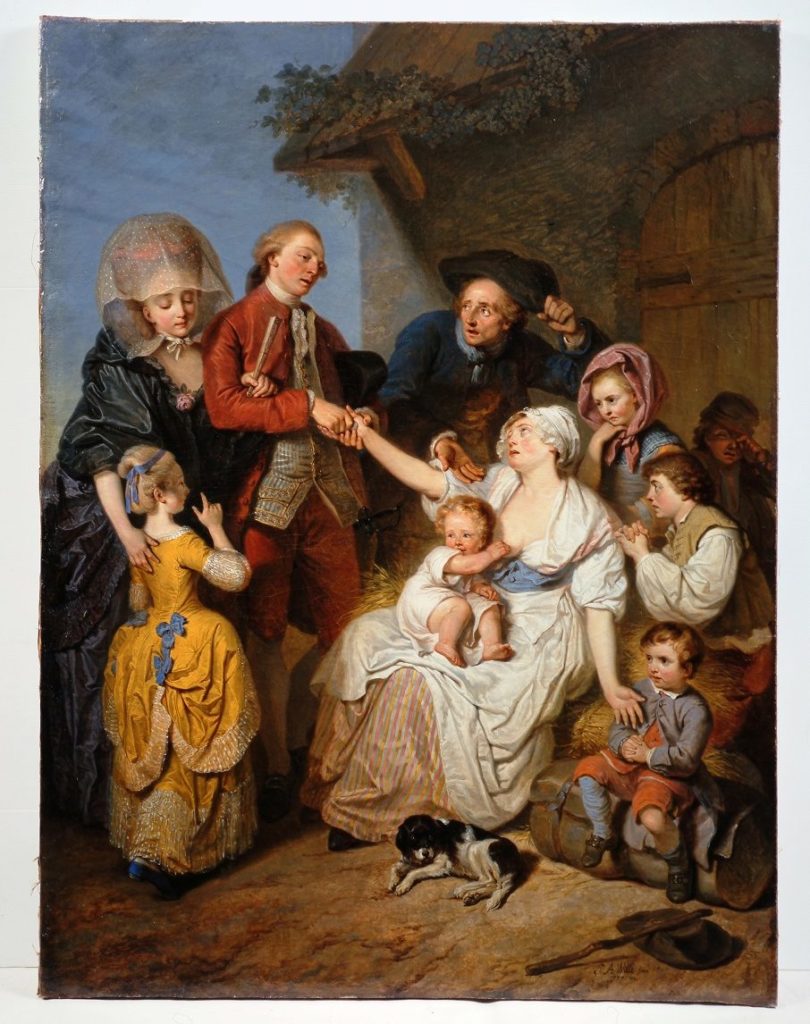
The works in question are four genre pictures that Wille showed at his second outing at the Salon of 1777.[4] These he deemed important enough to merit lengthy individual descriptions in the exhibition livret, in contrast to the treatment accorded to the six other works he showed that same year or indeed the ten he had displayed at the Salon of 1775, all of which are listed with the briefest of explanations. As these descriptions indicate, the paintings were unified by their insistence upon virtuous deeds, enacted within the prosaic confines of daily life. The large-scale Charity (Fig. 1), shows a charitable couple ministering to the needs of a destitute peasant family. In The Festival of Good People, or The Reward for Virtue (Fig. 2), the most virtuous members of a village are rewarded for their goodness by the lord of the manor. Meanwhile, Filial Duty and The Rest of the Good Father (both untraced) celebrate the rewards of parenting: in each of these smaller genre scenes, an elderly man is lovingly cared for by devoted offspring.
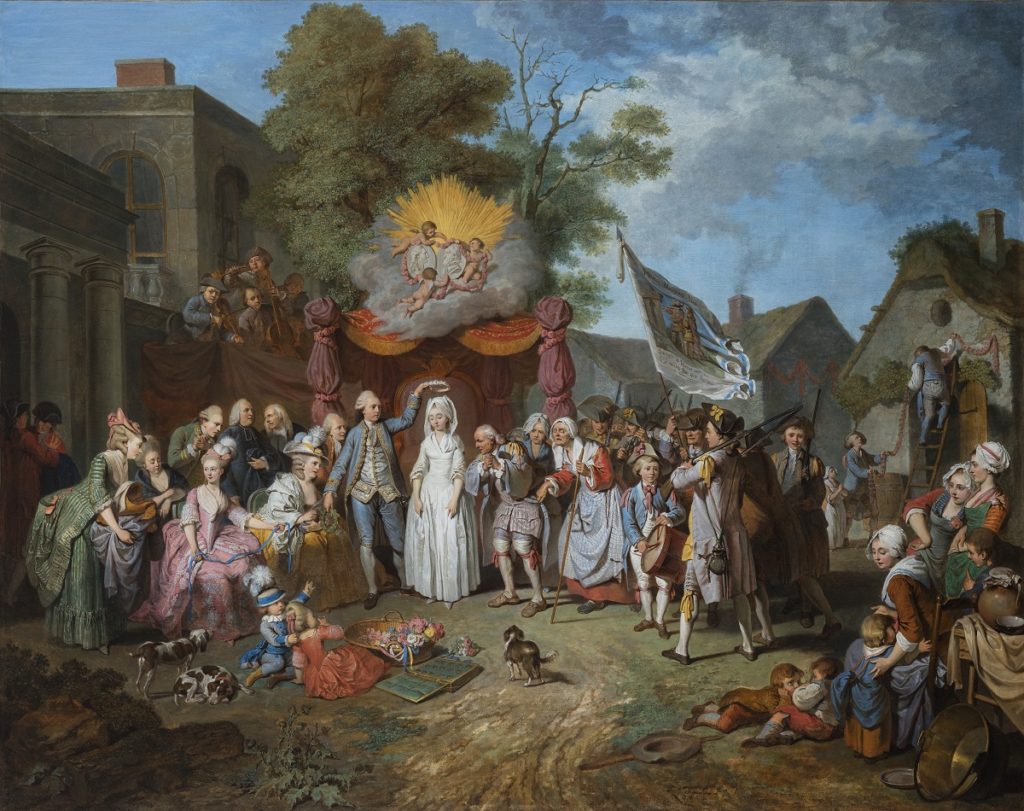
As the livret’s descriptions make readily apparent, Wille’s paintings contain numerous thematic similarities with the scenes of moral quandary and family tension made famous by the eminent Greuze. For instance, Charity, essentially a painted ode to the importance of teaching children the joys of good works (“the mother attempts to discover whether her daughter is moved at the sight of destitution”) parallels Greuze’s Charitable Lady (Fig. 3), in which a girl extends a purse to an impoverished convalescent under her mother’s benevolent gaze.[5] Filial Piety (Fig. 4), Greuze’s tour de force of familial duty, finds an echo in Wille’s crippled and dependent paterfamilias in Filial Duty and The Rest of the Good Father.
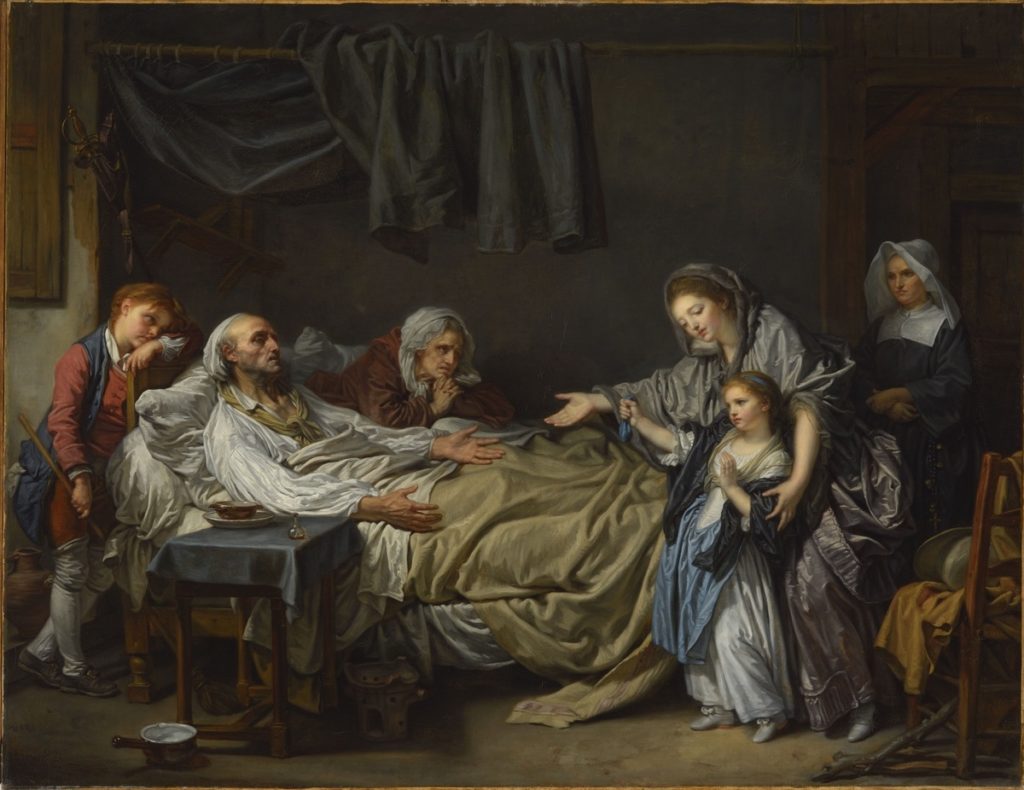
It is not surprising to discern a quotient of emulation in Wille’s works. After all, Greuze had taught him painting between 1761 and 1763. Transmitting knowledge to the son was just one of the ways in which Greuze and the prominent engraver Jean-Georges Wille expressed their friendship while it lasted: professional favors, trinkets, and works of art also changed hands.[6] But by 1777, there was no love lost between the painter and either Wille, father or son, as Greuze fought back against the encroachment on his trademark subjects. Shortly after the opening of the Salon, the anonymous Mémoires secrets leveled an accusation of plagiarism against Wille, averring that Filial Duty was nothing more than the painted rendering of an idea that Greuze had committed to paper more than fifteen years earlier.[7] In advancing the argument that a preparatory drawing had been found and plagiarized by Wille, the writer revealed his source—for who aside from Greuze himself could have known of its existence?
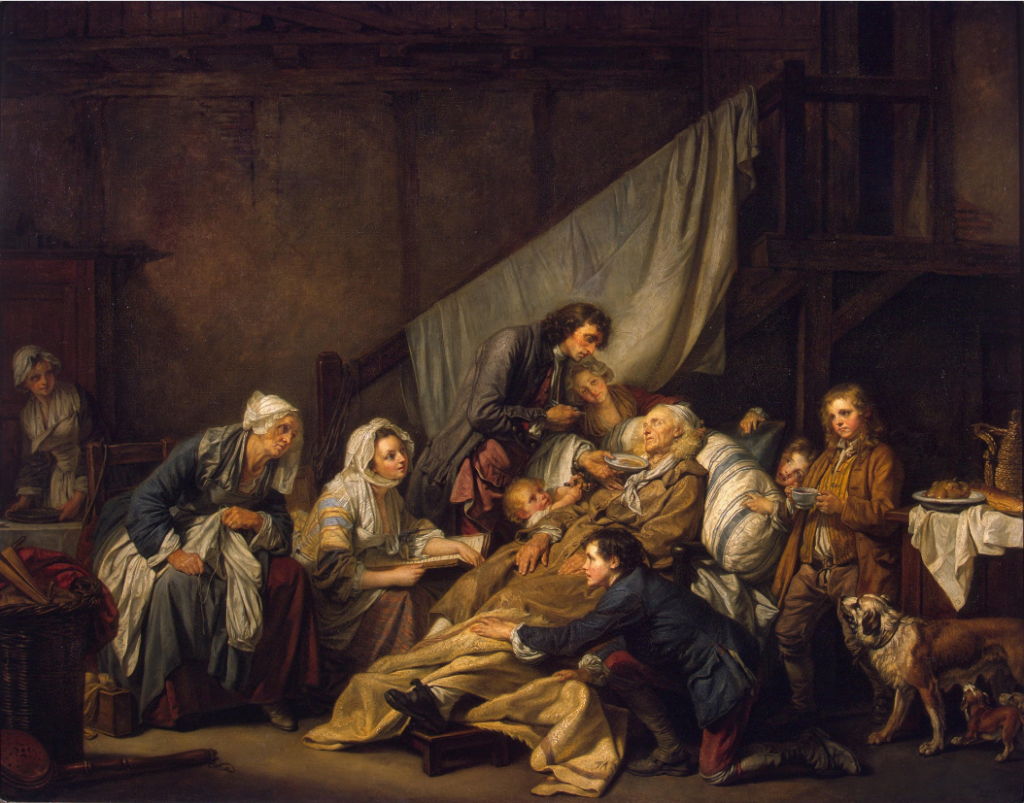
Neither the subjects of these socially enlightened works nor their place in Wille’s career—nor, indeed, the events that followed their public display—have gone unmentioned. But until recently only the whereabouts of Charity were actually known, and much of the discussion has been based on readings of relevant primary texts. While Filial Duty and The Rest of the Good Father remain out of reach, save for black and white illustrations, the recent rediscovery of The Festival of Good People on the Parisian art market affords an opportunity for visual study of what was, along with Charity, the largest and most complex of Wille’s submissions to the Salon of 1777.
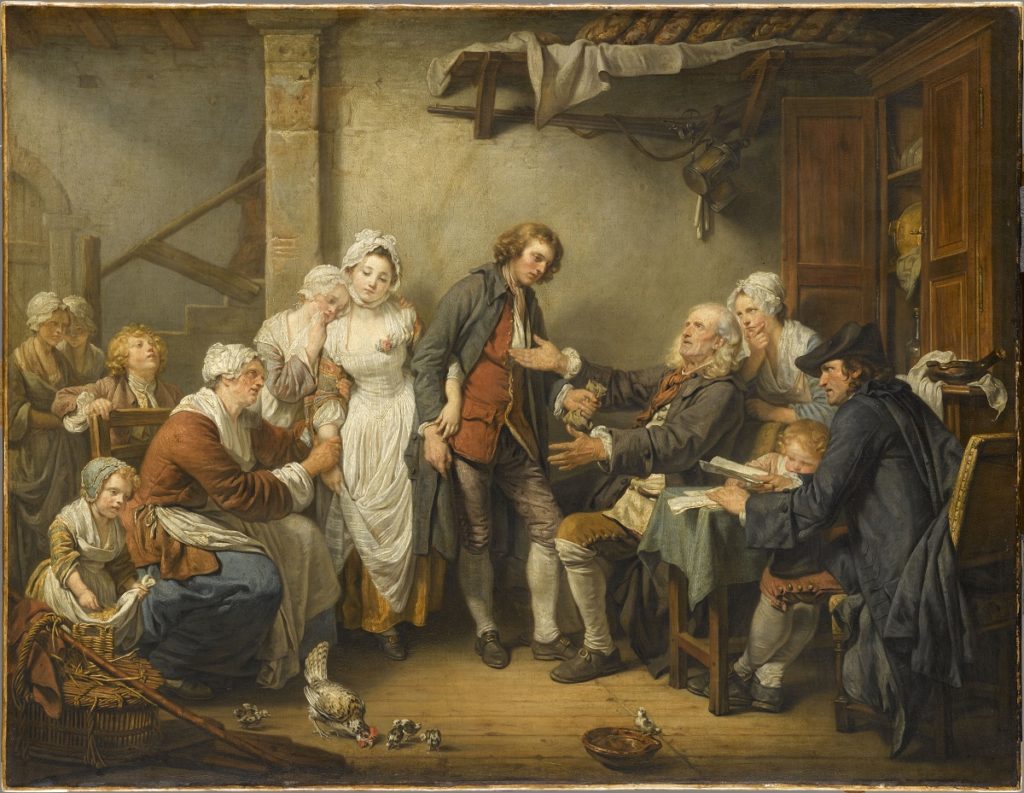
This examination indicates that Wille’s borrowing extended beyond the order of the conceptual, for it becomes clear that the heads and poses of the central protagonists populating his scenes are essentially plucked straight from the canvases of his former teacher. For example, the central white-clad girl crowned with roses in the Festival of Good People is nearly identical to the heroine of The Village Bride (Fig. 5), down to her demurely averted gaze and arms that fall passively on either side of her body. The surrounding figures also find their origin in Greuze’s composition: the aide standing behind the crowning official and the seated woman to his left closely echo the bride’s solicitous sister and mother. Wille had ample opportunity to observe the progression of work on The Village Bride,since he started his apprenticeship with Greuze some months before that painting was shown to rapturous praise at the Salon of 1761.
It is curious that the Mémoires secrets—presumably conveying Greuze’s own argument—overlooks Wille’s systematic visual borrowing to focus so entirely on the theft of the ideas and on the single example of Filial Duty. Of course it is possible that this painting was a lightning rod for Greuze’s fury because it was owned, per the livret, by the marquis de Véri, hitherto one of Greuze’s best clients.[8] It is also evident that Greuze relied upon his knowledge of copyright, tested in the course of his experiences of having his multi-figural compositions engraved.[9] By these rules, his drawing represented a message to be patented, not a complete visual experience.[10] But had not Wille also lifted bits of The Village Bride, and, for that matter, Filial Piety and The Charitable Lady? The Mémoires secrets overlooks these infringements and maintains that Wille’s real fault was his poor execution of Filial Duty. It would have been a better painting left in the hands of the inventor, Greuze, whose thinking had evolved in the fifteen-year interval between inspiration and execution. In other words, the report glosses over the fact that Wille had not only appropriated the general tenor of Greuze’s work but had also reproduced in paint many of its protagonists.
Why would Greuze, speaking through the journalist, have minimized the fact that his ambitious young student had so thoroughly imitated the expressions and attitudes of his figures? There is of course the practical explanation: Greuze would have had difficulty proving his case. Wille’s thematic appropriation of Greuze is systematic, but his visual emulation is more selective, suggesting that he took what he needed to create an emotional impact while steering clear of outright copying.[11] But there may also be a more subtle mechanism at work. Greuze may have wished to dissemble the extent to which he felt exposed by Wille’s actions precisely because something fundamental about his artistry had been essentially pinpointed and repurposed by Wille: his heads.
Wille knew his teacher well, and he knew from personal experience the profound importance Greuze attached to the representation of the human face. Not only had Jean-Georges Wille purchased from Greuze multiple head studies, including a drawing in red and black chalk for the head of the father in The Village Bride,but Greuze had, for his part, expressed his friendship towards the Wille family with offerings of faces: the portrait of Jean-Georges (1763; Paris, Musée Jacquemart-André) to whom he also dedicated a cahier of Têtes de différents caractères drawn notably from Filial Piety.[12] And extending back further than Greuze’s doomed friendship with the Wille family was the incident that, in 1755, became the basis for Greuze’s very relationship to the Académie royale de peinture et de sculpture. Members of that elite body were initially skeptical of the abilities of the young Greuze, who had not been trained by one of their own. To prove that the head studies and portraits for which he was then receiving considerable attention actually were by his own hand, Greuze painted the likeness of Louis de Silvestre, director of the Académie, in a demonstration attended by all the members of that elite body.[13]
If Greuze’s academic identity was thus essentially premised upon his ability to capture likeness, his subsequent reputation—in the eyes of critics, the general public, and collectors—was founded upon this same reputation as painter of the human visage sans pareil, as an artist whose craft was entirely premised on his uncanny ability to capture all the nuances of feeling and expression in paint. Not for nothing did the history painter Jean-Joseph Taillasson write in his obituary of Greuze:
What earned him the most important part of his glory, what won him the highest place in the opinion of artists and refined connoisseurs, were the beautiful heads spread throughout all the cabinets of Europe and which are there admired as masterpieces […].[14]
And it is precisely on these trademark grounds—Greuze’s heads—that Wille challenged his teacher’s primacy with act after act of sharply observant imitation. Faced with Wille’s contribution to the Salon of 1777, it must have been difficult for Greuze to shake the sinking feeling that his former pupil had rendered the essence of his artistic personality for all to see. Wille’s genre pictures were not portraits in the formal sense of the term. But in their enumeration of the very qualities that Greuze prized, they ruthlessly captured in paint the older artist’s image of himself and set it on display for all to see.
Yuriko Jackall is Curator of French
Paintings at the Wallace Collection, London
[1] See in particular Emma Barker, Greuze and the Painting of Sentiment (Cambridge: Cambridge University Press, 2005), 165-166, which illustrates Filial Duty and The Rest of the Good Father. On Greuze’s interest in authorship see Katie Scott, “Authorship, the Académie, and the Market in Early Modern France,” Oxford Art Journal 21:1 (1998), 30. On the consolidation of notions of authorship, performance of self, and artistic practice at this time period, see Charlotte Guichard, “Signatures, Authorship, and Autographie in Eighteenth-Century French Painting,” Art History 41:2 (2018), 266-292.
[2] See the indispensable chronology compiled by Edgar Munhall in Jean-Baptiste Greuze, 1725-1805, exhib. cat. (Hartford: Wadsworth Atheneum, 1976-1977), 22; and, more recently, Greuze et l’affaire du Septime Sévère, exhib. cat. (Tournus: Hôtel-Dieu-Musée Greuze, 2005).
[3] For an in-depth study of copyright and intellectual property in the Paris art world, see Katie Scott, Becoming Property: Art, Theory and Law in Early Modern France (New Haven: Yale University Press, 2018).
[4] On Wille, see Louis Hautecoeur, “Pierre-Alexandre Wille le fils (1748–1821),” Archives de l’art français VII (1913), 440-466.
[5] Explication des peintures, sculptures, & d’autres Ouvrages de Messieurs de l’Académie Royale, qui sont exposés dans le Salon du Louvre (Paris: 1777), no. 168: “… la mère cherche à découvrir si [l’] âme [de sa fille] est émue à l’aspect de l’indigence…” The other three paintings discussed here appear under numbers 169–171.
[6] See Hannah Williams, Académie Royale: A History in Portraits (Ashgate: Farnham, 2015), 233-241.
[7] “Lettre II. Paris, ce 15 septembre 1777,” Mémoires secrets XI (1777), 22-24.
[8] See Colin B. Bailey, Patriotic Taste: Collecting Art in Pre-Revolutionary France (New Haven and London: Yale University Press, 2002), chapter 4.
[9] Scott, “Authorship,” 30.
[10] This same preoccupation with intellectual theft—of ideas rather than images—resurfaced two years later when Étienne Aubry (1746–1781) exhibited Un fils repentant, de retour à la maison paternelle for which the preparatory drawing (private collection) reveals that the artist had clearly cribbed from Greuze’s own Fils puni (1778; Paris, Musée du Louvre). See “Lettre III,” Mémoires secrets, XIII(1779), 217.
[11] In 1777 Wille also exhibited two heads of old men, a subject very much in the vein of Greuze who had made a habit of exhibiting head studies alongside his genre paintings. Yet one of these, also in Angers (MBA J 183 (J1881) P), bears little in common with Greuze’s style.
[12] Jean-Georges Wille, Mémoires et journal de J.-G. Wille, graveur du roi, 2 vols (Paris: 1857), 1:173.
[13] Louis Gougenot, abbé de Chezal-Benoît, “Album de voyage en Italie,” ms I, 138-141 (Paris, private collection in 1977), cited in Jean-Baptiste Greuze, 1725–1805 (1976-1977), 18.
[14] “Notice sur Creuze [sic]” Journal des débats et loix [sic] du pouvoir législatif et des actes du gouvernement, 6 germinal an 13 [27 March 1805]: “Mais ce qui lui a mérité la plus belle partie de sa gloire; ce qui lui assigne une très haute place dans l’opinion des artistes et des connaisseurs délicats, ce sont les belles têtes répandues dans tous les cabinets de l’Europe, et qui y sont admirées comme des chefs-d’oeuvre […].”
Cite this note as: Yuriko Jackall, “Off with Greuze’s Heads: A Case of Identity Theft,” Journal18 Issue 8 Self/Portrait (Fall 2019), https://www.journal18.org/4204.
License: CC BY-NC
Journal18 is published under a Creative Commons CC BY-NC International 4.0 license. Use of any content published in Journal18 must be for non-commercial purposes and appropriate credit must be given to the author of the content. Details for appropriate citation appear above.
